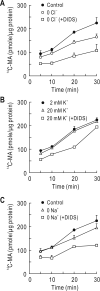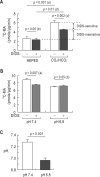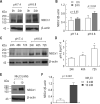Sodium-bicarbonate cotransporter NBCn1 in the kidney medullary thick ascending limb cell line is upregulated under acidic conditions and enhances ammonium transport
- PMID: 20591978
- PMCID: PMC2923243
- DOI: 10.1113/expphysiol.2010.053967
Sodium-bicarbonate cotransporter NBCn1 in the kidney medullary thick ascending limb cell line is upregulated under acidic conditions and enhances ammonium transport
Abstract
In this study, we examined the effect of bicarbonate transporters on ammonium/ammonia uptake in the medullary thick ascending limb cell line ST-1. Cells were treated with 1 mm ouabain and 0.2 mM bumetanide to minimize carrier-mediated NH(4)(+) transport, and the intracellular accumulation of (14)C-methylammonium/methylammonia ((14)C-MA) was determined. In CO(2)/HCO(3)(-)-free solution, cells at normal pH briefly accumulated (14)C-MA over 7 min and reached a plateau. In CO(2)/HCO(3)(-) solution, however, cells markedly accumulated (14)C-MA over the experimental period of 30 min. This CO(2)/HCO(3)(-)-dependent accumulation was reduced by the bicarbonate transporter blocker, 4,4-diisothiocyanatostilbene-2,2-disulfonate (DIDS; 0.5 mM). Replacing Cl(-) with gluconate reduced the accumulation, but the reduction was more substantial in the presence of DIDS. Incubation of cells at pH 6.8 (adjusted with NaHCO(3) in 5% CO(2)) for 24 h lowered the mean steady-state intracellular pH to 6.96, significantly lower than 7.28 for control cells. The presence of DIDS reduced (14)C-MA accumulation in control conditions but had no effect after acidic incubation. Immunoblotting showed that NBCn1 was upregulated after acidic incubation and in NH(4)Cl-containing media. The Cl(-)-HCO(3)(-) exchanger AE2 was present, but its expression remained unaffected by acidic incubation. Expressed in Xenopus oocytes, NBCn1 increased carrier-mediated (14)C-MA transport, which was abolished by replacing Na(+). Two-electrode voltage clamp of oocytes exhibited negligible current after NH(4)Cl application. These results suggest that DIDS-sensitive HCO(3)(-) extrusion normally governs NH(4)(+)/NH(3) uptake in the medullary thick ascending limb cells. We propose that, in acidic conditions, DIDS-sensitive HCO(3)(-) extrusion is inactivated, while NBCn1 is upregulated to stimulate NH(4)(+) transport.
Figures








References
-
- Boldt M, Burckhardt G, Burckhardt BC. NH4+ conductance in Xenopus laevis oocytes. III. Effect of NH(3). Pflügers Arch. 2003;446:652–657. - PubMed
-
- Bourgeois S, Masse S, Paillard M, Houillier P. Basolateral membrane Cl-, Na+, and K+coupled base transport mechanisms in rat MTALH. Am J Physiol Renal Physiol. 2002;282:F655–F668. - PubMed
-
- Brosius FC, Nguyen K, Stuart-Tilley AK, Haller C, Briggs JP, Alper SL. Regional and segmental localization of AE2 anion exchanger mRNA and protein in rat kidney. Am J Physiol. 1995;269:F461–F468. - PubMed
-
- Burckhardt BC, Frömter E. Pathways of NH3/NH4+ permeation across Xenopus laevis oocyte cell membrane. Pflügers Arch. 1992;420:83–86. - PubMed
Publication types
MeSH terms
Substances
Grants and funding
LinkOut - more resources
Full Text Sources

